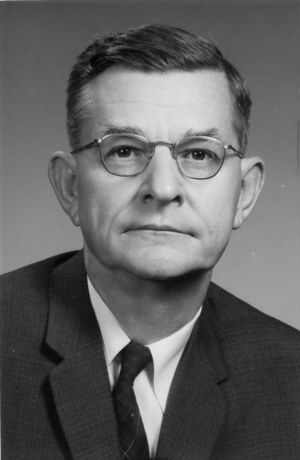James D. Cobine
- Birthdate
- 1905
- Birthplace
- Oklahoma City, OK, USA
- Death date
- January 1970
- Associated organizations
- General Electric (GE)
- Awards
- IEEE Lamme Medal
Biography
James D. Cobine (IRE Associate, 1934; Senior Member, 1944; and Fellow, 1957) was born in Oklahoma City, Oklahoma, on 10 May 1905. He died in August 1980 in Schenectady, New York. Cobine grew up in Oklahoma City and began preparing for his career as a physicist and electrical engineer at the University of Wisconsin, where he received the B.S.E.E. degree in 1931. He then earned the M.S.E.E. degree and the Ph.D. in electrical engineering and physics from the California Institute of Technology, Pasadena, in 1932 and 1934, respectively.
From 1933 to 1934 he was an Assistant at the California Institute of Technology, and from 1934 to 1935 he was a Graduate Assistant at the Harvard University, Graduate School of Engineering, Cambridge, Massachusetts. He remained at Harvard as Instructor, 1935 to 1938.; Faculty Instructor, 1938 to 1941; and Assistant Professor, 1941 to 1945. During World War II, Cobine remained at Harvard, teaching Army and Navy officers in the Cruft War Course, and from 1943 to 1945 he was Group Leader of the Harvard Radio Research Laboratory (OSRD). His group devised methods for creating noise as a radar countermeasure. Out of this work the discovery was made that a magnetic field enhances the noise output of a discharge through a gas, which led to his development of a powerful source of wideband noise that was in use in most radar jammers by the end of the war. Cobine served as part of the Pulse Transformer Committee of the Radiation Laboratory at MIT during the war and as a consultant to the psycho-acoustic Laboratory of the National Defense Research Committee at Harvard. For his many wartime contributions, he was awarded the Army-Navy Certificate of Appreciation.
In 1945, Cobine joined the staff of the General Electric Company’s Research Laboratory as a physicist, and spent the rest of his career with the corporation. He had a wide-range of interests and talents, so he worked on disparate topics such as inert gas welding, light amplification, magnahydrodynamics and the acceleration of mass to a velocity. His most recognized work was his development of high-power vacuum interrupters, which replaced earlier oil-based current interruptors. The new invention proved highly effective, cost efficient and widely applicable, and therefore had far-reaching consequences for power transmission and distribution. For this work, in 1969 Dr. Cobine was awarded the IEEE’s Lamme Medal “for his contributions to the knowledge and development of gaseous discharge devices and their adaptation to the development of high-power vacuum interrupters.”
In 1952, taking stock of the developing technology, Cobine was convinced that the time had come to mount an all-out assault on the electrode problems, and GE agreed. He began an intensive nine-year program culminating in 1961, when GE was able to announce the world’s first high-power vacuum recloser—one that was rated in the distribution range. In 1962, Cobine’s many contributions to this enormously significant development were celebrated at a special switchgear session of the winter general meeting of the American Institute of Electrical Engineers (AIEE, now IEEE).
During his career, Cobine was awarded dozens of patents, published many technical papers, and received many awards, including the Army-Navy Certificate of Appreciation. While employed at Harvard University Cobine published “Gaseous Conductors,” which became standard in the field for decades, in 1941. His field of specialization was electrical discharges in gases, high current arcs, and noise in gas discharges. He was a member of the Advisory Board of the Research Council at Rutgers University from 1950 to 1959. Cobine was a fellow of the IEEE, a member of the National Society of Professional Engineers, the American Society of Engineering Education, the American Institute of Physics, Sigma Xi, Tau Beta Pi, and Eta Kappa Nu. He died in August of 1980 in Schenectady, New York.
